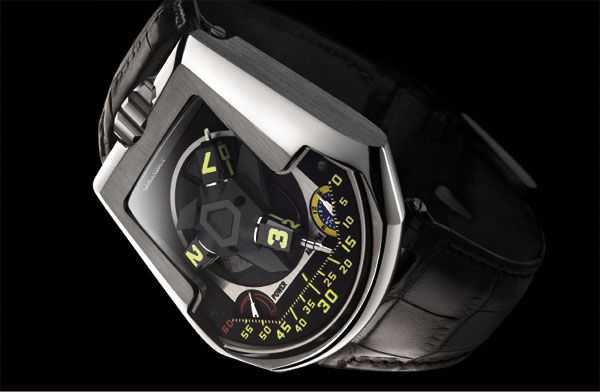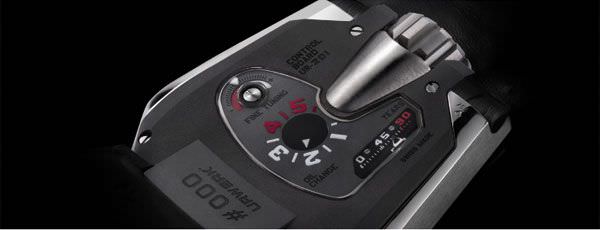
Everyone remembers the Opus V that Félix Baumgartner developed for Harry Winston. The first truly tri-dimensional watch in the history of timekeeping, it indicated the time thanks to studs that turn on themselves at the end of the arms of a satellite.
With the 201, Urwerk takes another step and equips the brand’s watch with an absolute first: retractable hands!
A unique approach
But let’s return for a moment to the debut of Urwerk’s adventure, since the 201 is the result (one of the results) of a unique and singular approach to watchmaking, conducted step by step with remarkable constancy. Contrary to most other talented young watchmakers, Félix Baumgartner renounced the domain of traditional complications (tourbillon, perpetual calendar and other grand sonneries) to concentrate on researching the different ways of indicating time. His objective? “To transform the display of time into an art form,” as he likes to say. In this vein, he developed a system of hour satellites that are available in different forms depending on his various models. The 201 is a direct result of this satellite concept, only Baumgartner has pushed logic as far as possible.

At the centre of the watch is a turning carrousel, created like a futuristic propellor that has been diamond-set, satin-finished, and treated with PE-CVD ‘blacktop’. The real ‘nerve centre’ of the watch, with specifications demanding machining to the nearest micron, it commands not only the rotation of the hour studs that are situated at the end of the three arms, but also the movements of the three telescopic hands.
At the interior of its arms are ‘transporters’, mechanical elements that control the extension or retraction of the hands. When a stud gets to the end of the minute scale, the hand completely travels over it to mark the minute, then its gradually retracts when the stud gets to the end of the 60-minute scale. It then continues its course around the watch (replaced at the beginning of the scale by the following stud that indicates the next hour).
“Each of the transporters has a thickness of 0.895 mm, and is covered with a 0.0005 mm MOVIC lubrication treatment, which allows the system to operate practically without oil. Knowing that the height of the carrousel is 0.0905 mm, the margin for error in the design of the system is 0.005 mm,” explains Félix Baumgartner.
Yet, the system of retractable hands is perhaps even more ‘crazy’ than this. Passing from 1.8 mm in length in the retracted position to 4.8 mm when fully extended, the hands contain an internal spring measuring 70 microns (0.07 mm) in diameter, or in other words, less than the thickness of a human hair (100 microns).
A technical back
While the face of the watch displays the time, as well as the power reserve (50 hours) and day/night indications (because the studs go from 1 to 12), the back of the timepiece is a true technical dashboard comprising a number of very interesting innovations: an oil-change indicator which, as it draws its winding energy from the crown, passes from white to red letting the watch’s owner know that the watch needs servicing; an odometer in kilometres, inspired from the gauges of sports cars that deduct, over 100 years and more, the total number of years of the watch’s operation, in six-year segments; and an adjusting screw that permits the wearer to precisely adjust the operation of his timepiece (more or less 30 seconds per day) according to whether his lifestyle is more or less active (which has an influence on the operation of the watch).

The design of the 201, due to the talented pen of Martin Frei, as are all of the Urwerk creations, is totally inseparable from the technical aspects we have just described. This is one of the great strengths of the duo forming Urwerk, in other words, they like to proceed in an organic fashion. “Here, my vision was that of a galactic vessel,” explains Martin Frei, “but with a quasi-bestial form, charged with power. It imposed itself on me, and I have repeated it relentlessly, in different viewing angles, in the face, the back, the side view. I baptized it Hammerhead."
In the watchmaking ‘jungle’, the 201 is decidedly a ‘bestial’ timepiece. Totally unlike any other, it demonstrates that the art of watchmaking has still many lands to explore. “What drives me,” says Baumgartner, “is a passion for risk, for technical challenges, and the desire to discover new territories. As a small structure, totally self-financed, with no debt or investors, we can develop step by step, as we intend to do. Above all, we are watchmakers, not businessmen. But the 201 took three years of development, and more than a million Swiss francs of investment, as well as an enormous engineering effort that started from zero. The case was incredibly difficult to machine and the sapphire crystal was very complex to make. It is only because our previous timekeepers were so successful that we were able to finance all the operations for the 201.”
Quantitatively, this represents about 185 pieces produced in 2006, with a basic price of CHF 65,000, distributed by several of the best doors in the world, from Chronopassion in Paris to Marcus in London, and including Hour Glass in Singapore, John Simonian in the USA, Chrystal in the Ukraine, and Les Ambassadeurs in Switzerland, among others.
As Félix Baumgartner and Martin Frei declare, “In the beginning, it was vision, and it took ten years for this vision to become a reality.” And what a reality it is!
Source: Europa Star April-May 2007 Magazine Issue




